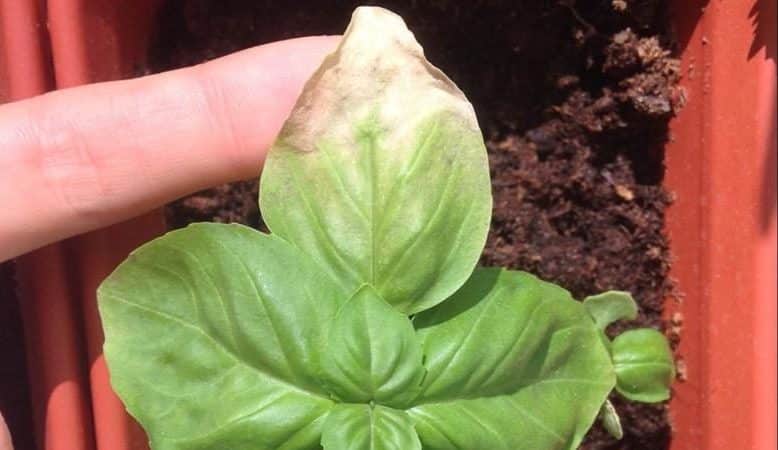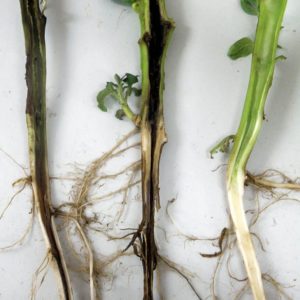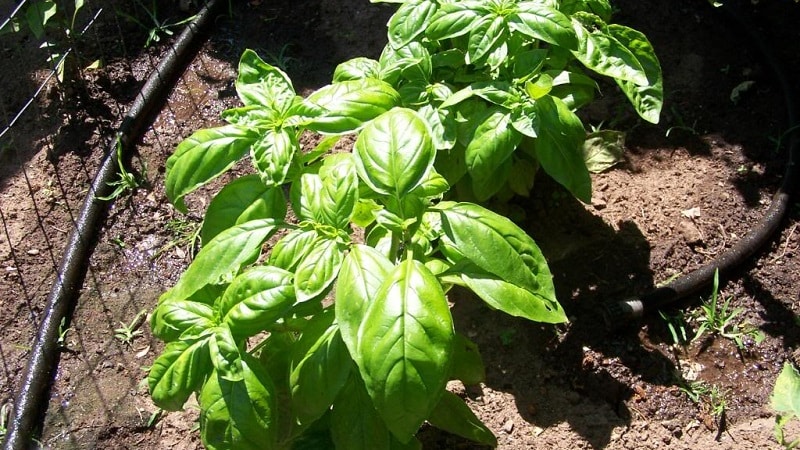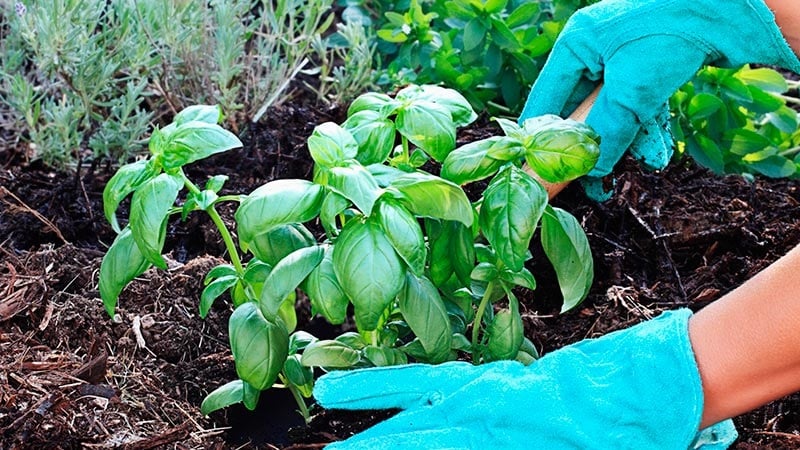We find out why basil turns yellow and eliminate the problem effectively
Basil is an aromatic spice that is an essential ingredient in many Italian dishes. It is combined with meat and vegetables, and is even added to desserts and sweet drinks. It is possible to grow such grass in the climatic conditions of our country both in open ground and at home, in a pot on the windowsill.
Basil is very unpretentious. It does not require much attention from the gardener, but it is still worth following the basic rules of care and protecting the plant from diseases and pests. Otherwise, you may encounter a problem such as yellowing of the leaves. You will find out why this happens from the article.
Why does basil turn yellow?

Depending on the type, basil leaves are green or purple.. If they begin to turn yellow, wither, dry out and fall off, it means the plant is in uncomfortable conditions. The reason may lie in improper care, infection with diseases and pests, or a lack of nutrients.
To determine why basil turns yellow, the signs that accompany the change in leaf color will help.
Diseases
The most common reason why basil dies when it receives quality care, – infection by infections. The aromatic seasoning affects several types of diseases.
Blackleg

Blackleg is a fungal disease that often affects young plants. The risk of infection is highest for basil growing in a greenhouse or on a windowsill.
The infection affects the root stalk of the seedling, clogging the vessels through which water and nutrients are delivered to the plant cells. Fungi also secrete enzymes that cause tissue decomposition. Because of this, the basil does not receive nutrition.
The disease is accompanied by the following symptoms:
- The base of the stem darkens, becomes soft, and the seedlings droop.
- The leaves become thinner, lighter, and fall off.
- The plant dies.
Blackleg cannot be treated, so it is important to eliminate the reasons leading to its development in advance:
- Stagnation of moisture. Occurs due to overwatering or lack of holes and drainage layer in the pot. Excessive soil moisture is the optimal condition for the development of fungal infection.
- Poor soil aeration. It occurs when the top layers of soil harden and stop allowing air to pass through. To destroy the earthen crust, the soil is loosened after each watering.
- Increased soil acidity. The plant loves neutral or slightly acidic soil.
If the black leg has affected several plants in a box of seedlings, you will have to throw out all the specimens growing in the same container. When infected in a greenhouse or open ground, only damaged specimens are dug up. The soil is treated with a light pink solution of potassium permanganate or copper sulfate.
Note! Purple basil is more disease resistant than green basil.
Gray rot
Gray rot is also a fungal disease. It often affects plants in greenhouses and at home.
Symptoms of the disease:
- Brown, gray and yellowish spots appear on leaves that are located near the ground. At this stage they are still dry.
- After some time, the stains begin to become wet. A gray coating forms on them.
- The disease spreads upward through the bush, affecting all leaves.
- The plant withers, acquires an unnatural yellowish tint, and dies.
They fight the disease with the help of fungicides, biological agents, and folk remedies.
Fusarium

Gray rot is another fungal disease that is destructive to basil.. The pathogen releases toxins that affect the plant vascular system.
The disease develops in warm weather under conditions of high humidity. Fungal spores are contained in the soil in a dormant state. Under favorable conditions, they wake up, begin to actively reproduce, and move onto the plant.
Symptoms of fusarium:
- The leaves of adult plants become thinner, turn pale, and turn yellow. Black and yellow-brown dots appear on them. The upper part of the bush begins to dry out and the plant disappears.
- The foliage of young basil becomes thinner and acquires a purple tint. Black and dark yellow dots appear on it. Basil dries and dies.
In the early stages of the disease, fusarium can be treated. If the disease is started, the basil will die and it will not be possible to save it.
Fungicides, such as Impact or Merpan, effectively combat fungal diseases. However, the chemicals penetrate into the structure of the leaves, reducing the environmental friendliness of the product.
Greens absorb harmful substances more strongly than other plants, so most gardeners try to avoid chemicals. They can be replaced with biological drugs, for example, Fitosporin. The product contains microorganisms that destroy harmful fungi. Such preparations cause less harm to the environment than fungicides and are safe for humans.
The safest option is folk remedies. They are used immediately after the first symptoms are detected. In advanced cases they are ineffective.
Experienced gardeners fight fusarium with onion decoction. To prepare it, take 1 part of onion peel and pour 4 parts of boiling water. The product is infused for 2 days, then filtered. Plants are sprayed with the solution every 5 days.
Pests
Another reason why basil has wilted and turned yellow may be pests.
Aphid

Aphids are small sucking insects that settle on basil in colonies. The pest has a translucent body of yellow, gray, green or brown color and a soft chitinous cover. The pest sucks juices from plants, leading to their death.
Aphids on basil are easy to spot. If you look closely at the bush, you can see many small insects on it, some of which have wings.
When infested by aphids, basil leaves turn pale, turn yellow, curl and dry out, and then fall off. Often a dark coating appears on them. This is a sooty fungus that develops on the sugary waste products of the pest.
Folk remedies are effective against aphids: infusions of hot pepper, dandelion, tomato tops, wormwood, onion and garlic peels. Fill the bucket a third with the selected plants, and the rest of the volume is filled with boiling water. The product is infused for a day, then filtered and used for spraying.
Another proven option is a solution of tar soap.. A bar of soap is rubbed and dissolved in a bucket of water. The product is used for spraying.
Spider mite

Spider mites are small pests that are red, black, green or brown. Actively reproduces in warm and dry air. It feeds on plant sap.
When basil is damaged by a mite, the leaves turn yellow, become thinner, droop, then dry out and fall off. The pest can be detected by cobwebs and black spots on the underside of the leaves.
To combat spider mites, use the same means as to remove aphids. Insecticides are also effective.
Snails and slugs
Slugs and snails feed on basil leaves. In this case, not only holes appear on the plant, but also yellow dry areas. The pests are large, so they can be seen with the naked eye.
To get rid of the problem, you need to find the snail nests and destroy them. Next, the plants are sprayed with a solution of ammonia. To prepare it, dissolve a bottle of ammonia in a bucket of water.

Bedbugs

Bed bugs are round insects that are green, black, red or yellowish in color. The pest sucks the juices out of the plant.
Leaves affected by the bug become shriveled and deformed. Yellowish spots appear in the place where the insect was attached. The basil becomes lethargic and gradually dies.
1 kg of ash is diluted with 2 liters of water and boiled for half an hour. The resulting mixture is diluted with 10 liters of cold water. The product is sprayed on plants affected by bedbugs. If this does not help, use the insecticides “Bankol” and “Aktellik”.
Errors in care
If the basil turns yellow and leaves drop, the problem may lie in improper care:
- Waterlogging of the soil. Excessive watering and stagnation of liquid leads to rotting of the root system. Because of this, the plant stops receiving nutrients, turns yellow and withers. Most common problem when growing basil in pots without holes and drainage layer.
- Lack of watering. Basil is a moisture-loving plant.When the soil dries out, it begins to dry out and die.
- Poor air circulation. After watering and precipitation, an earthen crust forms on the soil surface. It does not allow air to pass through to the root system, and moisture does not evaporate. This leads to damage and rotting of roots and the development of diseases.
- Thickened plantings. If the plantings are too dense or the bushes are spreading, the basil does not receive enough sunlight and turns pale. In pots, thickened seedlings stretch out and acquire a yellowish tint. Also, if there is not enough space, air circulation is disrupted, which increases the likelihood of plants becoming infected with fungus.
- Lack of sunlight. Basil is a light-loving crop. In the shade it begins to turn pale and becomes withered.
- Exposure to direct sunlight. When exposed to direct sunlight, yellow-brown spots appear on the basil - sunburn.
- Unsuitable soil. The plant turns yellow and dies in acidic, saline and poor soils.
- Weeds. They draw nutrients from the soil, the basil turns pale, becomes stunted, and dries out.
- Hypothermia. The problem arises if the plant is standing on a windowsill in a draft, the seedlings have been transplanted in open groundwithout pre-hardening, the basil was watered with ice water (in this case the roots begin to rot).
- Damage to the root system. In this case, the entire bush turns yellow and dies evenly. The roots can be damaged by loosening, weeding or using too concentrated fertilizers.
- Phosphorus deficiency. The leaves acquire a yellowish tint and are covered with red-blue spots.
- Nitrogen deficiency. In this case, only the tops of the leaf blades turn yellow. The growth of new greenery stops.

What to do if the basil turns yellow, how to save it
To save yellowed basil, first inspect it for symptoms of disease and pest damage.. Particular attention is paid to the underside of the leaves, where insects are often concentrated.
If pests and diseases are present, treatment is carried out. The composition is used to treat not only the affected plants, but also neighboring ones, as well as the soil in the garden bed. The most damaged parts and bushes are removed.
If there are no signs of infection, care is reviewed. If the soil is dry, water the beds; if it is waterlogged, allow it to dry and rake some soil up to the stem to stimulate the development of new adventitious roots.
Fertilization is often necessary. Choose products containing phosphorus and nitrogen. If the problem is advanced, it is worth using a growth stimulator, for example, Epin.
If the plant is in the shade, move it to a south-facing window sill or use a fluorescent lamp. In the garden, the shaded area will have to be cleared.
Hypothermia and damage to the root system are treated by applying fertilizers, hilling the bushes, and watering the soil with a weak solution of potassium permanganate. Be sure to loosen the soil around the plants.
What to do if it dries out
The plant dries out due to infestation by aphids, spider mites, and fusarium. The problem is also caused by insufficient watering or damage to the root system.
If most of the bush has dried out, the plant cannot be saved. If the problem has just arisen, water the basil with a solution of a root formation stimulator and a light pink solution of potassium permanganate. It is important to ensure that the basil receives enough sunlight during the recovery period.
If basil seedlings turn yellow and fall

If the basil sprouted and immediately falls down, and black spots are visible at the base, it means that it has been affected by blackleg. In this case, the ground is sprinkled with ash and allowed to dry.. The soil and plants are treated with fungicides.
Treatment does not always help. If unsuccessful, the affected basil is dug up, removed from the site and burned.
Seedlings fall if their stems are very elongated. To correct the situation, the plants need to be planted in individual pots, watered with a root formation stimulator (“Solution”), and moved to a bright and warm place.
Note! Basil seeds can sprout together with the shells, which lead to yellowing and death of the sprouts. To get rid of the problem, seedlings are sprayed with warm water every 5 hours until the seed skins fall off.
Preventive measures
Yellowing of basil is easier to prevent than to treat, so it is important to follow the basic rules of prevention:
- Disinfection. Before planting basil the soil and seeds are treated with a solution of potassium permanganate or copper sulfate. It is recommended to further calcinate the soil in the oven. All garden tools are disinfected before use.
- Loosening. The soil is loosened after each watering and precipitation. Be sure to remove weeds from the garden bed.
- Fertilizer application. Plants are fed every 2 weeks. Alternate mineral and organic compositions. Before applying fertilizers, the beds are watered abundantly.
- Correct watering regime. Moisten the basil as the soil dries completely. The procedure is carried out early in the morning or after sunset. The water should be at room temperature.
- Mulching the soil. It is recommended to cover the beds with a layer of mulch (straw, hay, humus).This will help improve air circulation, prevent moisture stagnation, and avoid the plant being damaged by diseases and pests.
- Digging the soil before planting. Before planting basil, dig up the soil to the depth of a spade bayonet.
- Compliance with crop rotation. Basil should not be planted in the same place for several years in a row. The best predecessors are legumes, for example, lupine.
Conclusion
Yellowing of basil leaves indicates that the plant will soon die. The reason lies in improper care, fungal infections or pests. In most cases, you can save basil if you provide it with timely assistance.